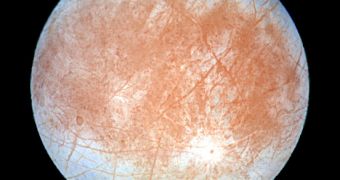You probably know Europa, though she's not a star... not even a planet in space.
Europa is a moon of the planet Jupiter. It is the sixth nearest moon to Jupiter, and the fourth largest of Jupiter's moons. It was discovered in 1610 by Galileo Galilei (and independently by Simon Marius shortly thereafter) and is the smallest of the four Galilean moons named in Galileo's honor.
Due to the hypothesized ocean beneath its icy surface, Europa is one of the most likely places in the solar system to host primitive extraterrestrial life.
Now meet ENDURANCE, an acronym for Environmentally Non-Disturbing Under-ice Robotic ANtarctic Explorer. It is a modified version of a device called DEPTHX - Deep Phreatic Thermal Explorer - developed by Austin, Texas inventor William Stone, and used to explore underwater caves in Mexico as part of NASA's Astrobiology, Science and Technology for Exploring Planets program.
Once that is complete, DEPTHX will be reengineered to become ENDURANCE, then tested next February in an ice-covered Wisconsin lake before making the trip to Antarctica in November. ENDURANCE will map Bonney for a month, then do a second mapping in 2009. Data gathered will be relayed back to Chicago where it will be used by UIC's Electronic Visualization Laboratory to generate various 3-D images, maps and data renderings of the lake.
What is interesting about this robot is the fact that, being designed to draw an underwater three-dimensional map showing the biological and geochemical composition of an ice-bound Antarctica lake, it may prove to be the ideal tool to search for life on other planets or moons where ice is known to exist.
So, a future robot based on the same technology is expected to penetrate the ice-covered sea that surrounds Europa, one of Jupiter's moons, sometime around 2019.
The $5 million machine has a unique navigation system that allows it to operate in unexplored areas without human help. Instead of relying on radio or satellite positioning, it memorizes 3D maps of its location to avoid getting lost.
Using its own "brain" and sophisticated instruments to analyze water samples, the robot will look for living organisms and test for signs of life. Dr Bob Stone, who is leading the NASA-funded project, said that: "It's like an all-seeing eyeball which gets a geometric lock on the features that surround it to work out its position."
It is thought that under the surface there is a layer of liquid water kept warm by tidally generated heat. The temperature on the surface of Europa averages about 110 K (-163 C) at the equator and only 50 K (-223 C) at the poles, and so the surface water ice is permanently frozen.
But some telescope images argue that Europa's geological features also demonstrate the existence of a subsurface ocean, so many scientists believe that this satellite is the most likely to host alien life, from all the others discovered so far.

 14 DAY TRIAL //
14 DAY TRIAL //